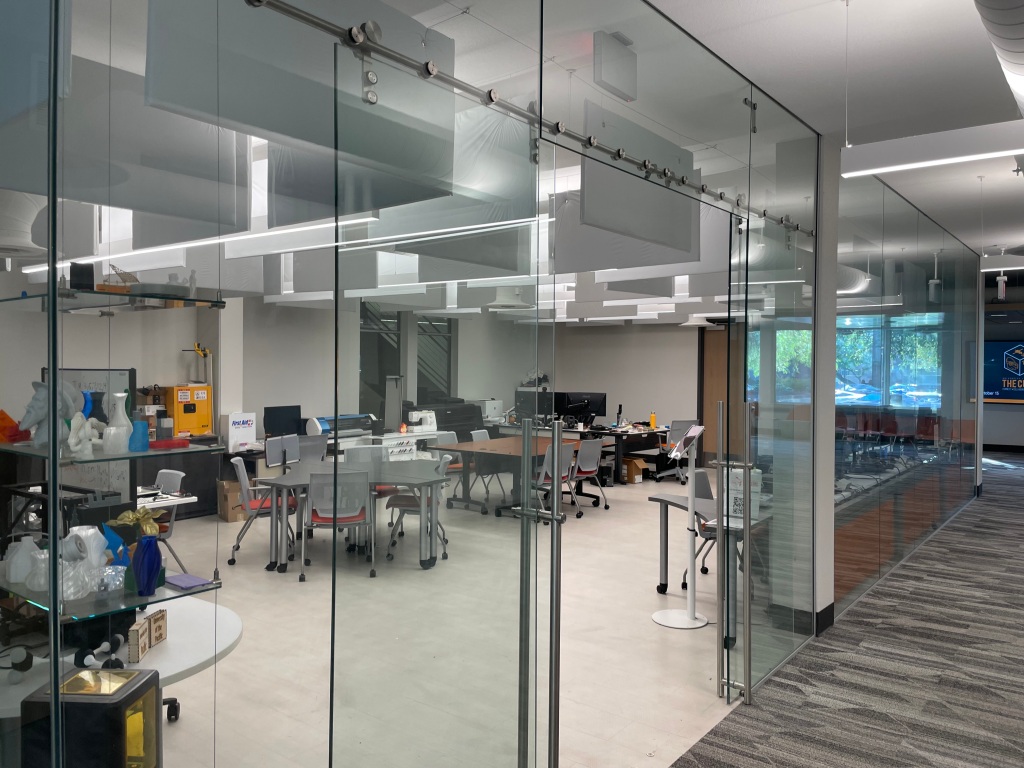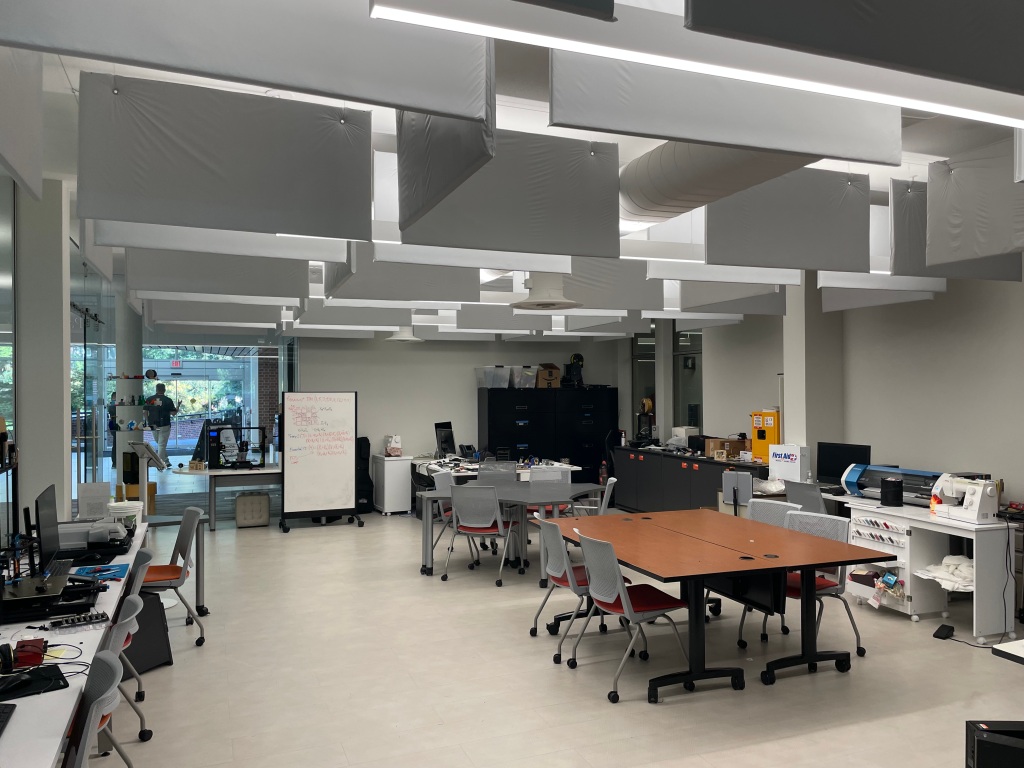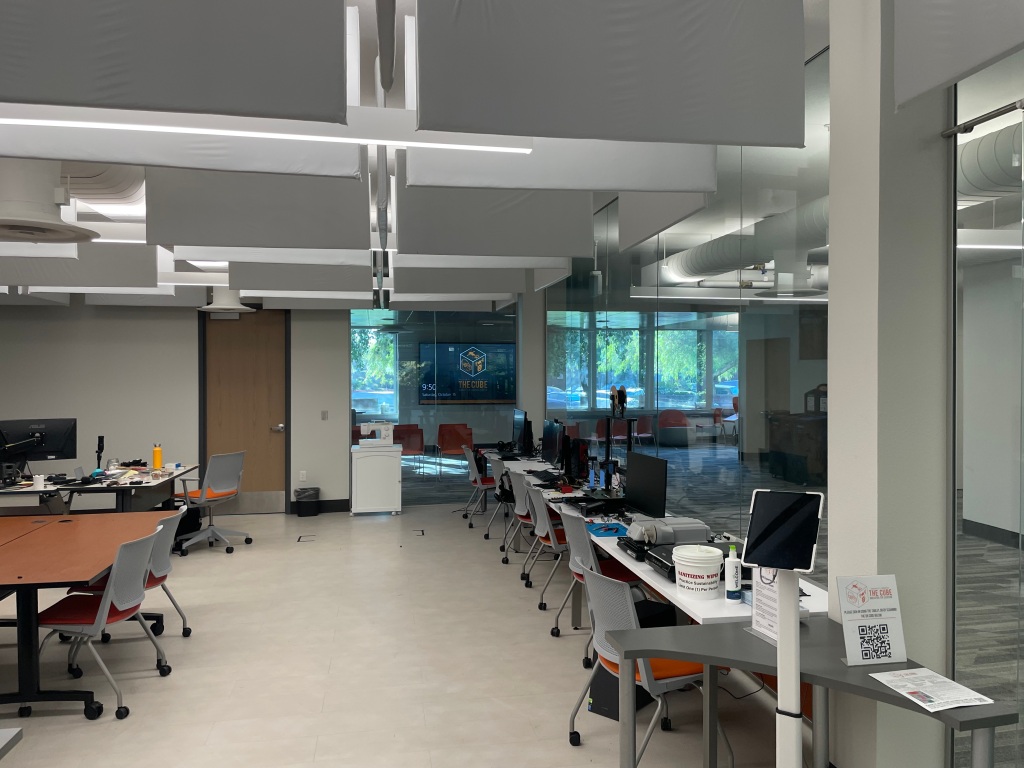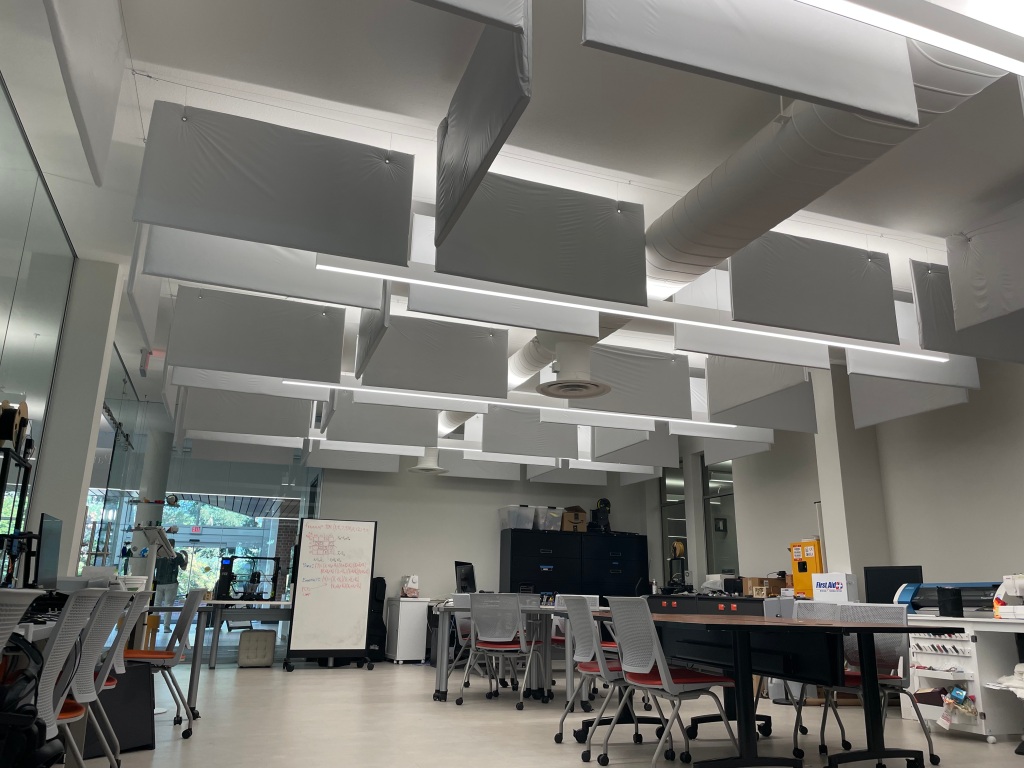Archive for category Teaching Rooms
Taming the Cube with Cloudscape®
Posted byAcoustics FirstinAbsorption,Classrooms,Customer Feedback,Manufacturing,Media Room,开云体育手机版 ,School & Educational Facilities,Teaching Rooms,Universitieson October 21, 2022
When the University of the Pacific reached out to help tame the acoustics of their makerspace called “The Cube”, many different concerns were underlined about the space, its uses, and the problems they faced.

These concerns covered more than just the room dimensions – size, height, HVAC, glass walls, etc…. there were functional requirements for collaboration, classes, and workshops. The overwhelming acoustic problems involved the near constant noises generated by the vast array of equipment in this space – sewing machines, large format printers, plotting cutters, 3D printers, scanners, and every other modern tool for allowing the creative minds at their school to create. It was a cacophony of stepper motors, fans, and moving parts – which made collaboration very difficult.

The other parameter that needed to be maintained was the ability to reconfigure the layout of the equipment without affecting the acoustic treatment in the space. This removed almost all of the walls in the space as possible locations for treatment. This left the ceiling as the only viable space left for treatment, but with an array of lights and exposed HVAC systems, there were few treatments that would be easy to implement and still be effective.

创造性地编织的决定Cloudscape® Bafflesinto all the spaces available in the ceiling. Dodging duct-work and suspended lighting rails was made possible with careful planning and execution – and the results were immediately notable. (Also noticeable was that thebaffleshad very little impact on the lighting which is vital in any makerspace.)

“…The sound baffles you recommended finally got installed in my makerspace about two weeks ago and I wanted to send a quick thank you since they’ve made a very noticeable acoustic difference to the room, and it’s a lot more pleasant in here now. “
Chris Crawford – Innovation Spaces Manager (University of the Pacific)
沉默®照片goes BIG for Ditch Witch®
Posted byAcoustics FirstinAbsorption,Classrooms,Customer Feedback,开云体育手机版 ,School & Educational Facilities,Teaching Rooms,Uncategorizedon September 16, 2021

When Ditch Witch® needed to acoustically treat their training room, they had a big and bold idea – take a cool promo photo and use that to make a沉默®照片mosaic! The required scale made it easier to break up the photo into a 3’x3′ matrix, which also eased the shipping and installation process! The final product (at over 9 feet tall and 15 feet wide) is imposing, and while it isn’tquitelife-sized, the impact is indeed massive!
“Thank you so much for all the help you and your team did on this project. Our training room is complete now.
Ditch Witch Midwest
We are over the moon happy.”
Little Safari Day Care – creating peace (and quiet), one pyramid at a time.
Posted byAcoustics FirstinAbsorption,Classrooms,Customer Feedback,Multipurpose Rooms,开云体育手机版 ,School & Educational Facilities,Teaching Roomson August 11, 2021
With more parents returning to the office, we’ve recently received a handful of treatment requests from day-care facilities dealing with an influx of boisterous children.
小Safari日托伸出我们在7月2日021 for help with their space. Little Safari’s multi-purpose room is used for play, music, reading, arts/crafts, meals, games etc….. lots of moving and laughing = lots of noise! According to the owner “The noise level is deafening at times to the point you can’t hear anything, just noise”

The fanciful mural on the playroom wall looks great, but when you look closer, that glossy painted surface reflects sound like glass! Luckily,Fireflex Pyramid foamcan quiet that down!
Technical consultant Cameron Girard settled on a remediation package that includedFireFlex Acoustic Pyramid Foam panelsdistributed throughout the ceiling of the multi-purpose room. Safe to say, they were very happy with the results!!

The checkerboard install of the foam helped to distribute the absorption over the loudest areas of the room.
From the owner…..“Cameron, Thank you for all of your help and expertise in sound suppression!!! I have had people tell me upon entering the front door “wow, it’s much quieter in here” Such a noticeable difference. You may have saved my hearing and sanity!!!”
DIY – Treating a Wall – BlockAid® and SoundChannels®
Posted byAcoustics FirstinAbsorption,Animal Shelters,Auditorium,Broadcast Facilities,Classrooms,DIY,Fitness,Government,Gymnasium,Home Entertainment,Home Theater,HOW TO,Media Room,Multipurpose Rooms,Music Rehearsal Spaces,Music Tracking Room,开云体育手机版 ,Recording Facilities,Recording Studio,School & Educational Facilities,Sound proofing,Studio Control Room,Teaching Rooms,Teleconferencing,Theater,Uncategorized,Vocal Booth,Voice Overon July 16, 2015
 On many occasions, we get asked about common ways to treat a wall (or walls) either for broadcast, podcast, or other voice recording scenario – where they not only want to tame the reflections within the room, but also block a certain amount of sound coming into – or leaving the room.
On many occasions, we get asked about common ways to treat a wall (or walls) either for broadcast, podcast, or other voice recording scenario – where they not only want to tame the reflections within the room, but also block a certain amount of sound coming into – or leaving the room.
Budget is frequently an issue, major construction is usually unwanted, but effective results are always required.
We’re going to show you how to handle a room upgrade – cut down on the sound transmission and cut the room reflections – all with the same skills required to hang high quality wall coverings! Let’s see how you can cover a wall withBlockAid® vinyl sound barrierto block unwanted sound, then go back and cover that with an absorptive layer ofSound Channels® wall coveringto finish it off!
This treatment is not recommended for renters, as this is not an easy upgrade to undo. However, if you have an extra bedroom you are using as Podcast studio, this is a great way to treat it… Let’s get started!
InstallingBlockAid®
Good job! Now, take a breather while that dries, and notice how much less sound is passing through the walls. This is when you will notice that the sounds are now coming from under the door, and through the leaky old window. These can be taken care of in different ways…. but the easiest way is the same way you deal with keeping the cold out! Get some weather strip, a door skirt, seal the gaps around the frame of the door, and windows, maybe go out and buy some heavy curtains for the windows… if you have some leftoverBlockAid®, you can always get some Industrial Velcro and temporarily stick a piece over the window!
InstallingSound Channels®
That’s it!
This treatment is a common first step in treating many professional broadcast studios – it gives you extra isolation with the barrier and takes the edge of the sound reflections. Many professional environments then go back and add some additional treatments such as bass traps, diffusers, and broadband absorber panels – especially if these studios are planning on bringing in any musical guests.
This isn’t just for home studios. It works great for kids play rooms, bedrooms, home theaters, home gyms, and any place you want to block sound and tame the sound inside the room.
Customize your space as you will, but this treatment is a consistent winner for cost and performance, and is a great way to get started without breaking the bank!
Big Room… Big Boom.
When Pippin Barnett contacted Acoustics First about an acoustical issue he was having with a new multipurpose space that was constructed for the Sabot School, he was in desperate need of a solution. This space was needed for functions, activities, art displays, music classes, plays, and more, but was almost completely unusable due to the acoustics.
 The large space was well conceived; large open floor plan, hydraulic door to open the space to the courtyard, bathrooms, storage and lots of display space for the student’s artwork and creations. The building was also efficiently constructed using SIPS (Structural Insulated Panel Systems), which created a grand open space with no support pillars.
The large space was well conceived; large open floor plan, hydraulic door to open the space to the courtyard, bathrooms, storage and lots of display space for the student’s artwork and creations. The building was also efficiently constructed using SIPS (Structural Insulated Panel Systems), which created a grand open space with no support pillars. This space was ready to be used, but there was a problem – whenever they tried using the space, you couldn’t understand what anyone was saying. To say that the acoustics were “not optimal” is like saying that the destruction of the entire universe would be “inconvenient” – an incredible understatement.
This space was ready to be used, but there was a problem – whenever they tried using the space, you couldn’t understand what anyone was saying. To say that the acoustics were “not optimal” is like saying that the destruction of the entire universe would be “inconvenient” – an incredible understatement.
Upon arrival, we took some physical measurements of the space to calculate the surface area and volume of the room, as well as got some acoustic measurements.
Click here for a balloon pop before acoustic treatment.
Whoa… Big Boom! What you are hearing is a 3+ second RT60 time; That’s more than 3 seconds of time that the sound lingers in your space at a level audible enough to interfere with other sounds.
Which is “Inconvenient,” and “Not Optimal.”
So with some magic calculations performed by Joe Horner over at the quietest office in Acoustics First,(no really – he likes it really quiet,) a solution was developed to create a space that sounded as good as it looked.
Joe prescribed 100 2’x4′ Cloudscape ceiling baffles as well as 157 sq ft of 1″ thick Sonora Wall panels to cover the solid hydraulic door – and we listen to Joe (he’s done this a lot!)
So, a short while later, the Baffles and Panels are installed and we receive an e-mail from Pippin…
“I’d say you were right on the money!”
Click here for a balloon pop after acoustic treatment.
RT60从3 +秒对吗t about 1 second. I’d say that’s right on the money too, Pippin!
The Sabot School regained the use of its space and everyone lived happily ever after.
I love happy endings.




















You must belogged into post a comment.